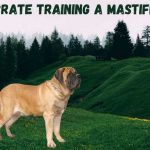Crate training a new puppy is not an easy task, what’s even more challenging is crate training a puppy with another dog in the house.
Getting two dogs to get along is not easy, especially that new puppies have no boundaries. And they don’t have the self-control that would allow them to respect the older dog’s space.
To build a good relationship between your dogs you need to introduce them properly.
Crate training is actually the best way to teach a new puppy the boundaries and how to react in the house.
Having a good and well trained older dog could actually be a great raw model for your new puppy.
So how do we introduce the new puppy to the older dog at first?
Introducing the puppy to the other dog
To properly introduce a puppy to a new dog you need to follow a few steps; to avoid any potential incidents that could prevent the dogs from ever getting along.
Choosing a neutral space
The first step is to choose a neutral space to start the introduction. Older dogs may be protective of their space and the house so you want to remove that tension.
Also having a friend or a family member to hold the puppy is even better if he is extra protective over you.
Even if your dog is not the territorial type it would be much better to play it safe and doing it in neutral space.
So once we have found a place where we can do the introduction, now we need to work on the older dog. The puppy needs to be controlled at all times since they are kind of unpredictable and you don’t want the puppy to trigger the older dog.
Making the older dog focus on you
You absolutely don’t want the older dog focusing on the puppy you want the puppy within a safe distance. Every time the older dog is checking up the puppy you want to regain their attention.
The older dog needs to be focusing on you just getting used to the smell of the puppy around.
If the dog is too concentrated on the puppy it may turn bad, so always pull the older dog back and use treats.
The treats will keep the dog concentrated on you instead of the puppy. And when the dog is comfortable around the puppy doesn’t really care much about his presence you can move on to the next step.
Getting closer to the puppy
You can now start to get closer to the puppy while keeping him still to avoid any sudden reactions.
Always have the older dog focusing on you and ignoring the puppy. Every time he checks the puppy for more than two seconds you need to pull him back to you.
If you see any bad reactions or the dog doesn’t respond to you; going backward is needed.
This is a slow process don’t just rush the dogs into a meeting and expect them to get along on the spot.
If anything goes wrong you will always have to control them in the house; so make sure everything goes as planned.
So if everything is going smoothly you can move to the next step and introduce the dogs.
Quick & controlled introduction
Now you can get even closer to the puppy a few feets away and let the older dog relax. When he is within a close distance and his focus is not on the puppy you can order him to say hi. This should be nose to nose for 2 or 3 seconds only the call him back.
If this goes as planned and the introduction is positive you can do it again and increase the time.
Do that a few times and you should be ok to move to the house.
Introductions in the house
Even if the introduction went really well and the older dog is showing no bad reactions toward the puppy; you can’t just put him in the house and around him.
The older dog needs to get used to having the puppy home, so how are we going to do that?
You need the playpen or the crate the older dog is the one that can move freely not the puppy. The older dog has already acquired indoor manners and behaves correctly in the house so it’s the puppy you want to control.
Just put the puppy in the crate or playpen and bring the older dog around it and don’t let him focus on the puppy.
Keeping the puppy’s personal space
Crate training is all about providing a safe and intimate den to the puppy. So the crate is a personal and safe space that no other dog should violate.
Crate training a puppy with another dog in the house is all about keeping the personal space of each dog.
Dogs are generally curios and other dogs may feel tempted to get into other dogs’ crates. You need to teach your older dog that the puppy’s crate is off-limits.
The best thing you can do is to have the puppy’s crate attached to the playpen where he can spend his time away from the older dog.
You also need to control the puppy as he is more likely to get into the older dog’s personal space which could result in a bad reaction.
Controlling the puppy’s environment
Crate training a puppy with another dog in the house automatically means that the puppy is at all times in a controlled environment.
He can not move freely around the house with the older dog also free.
The puppy needs to be in a crate or playpen close to your living area watching how the older dog is reacting around the house.
The puppy needs to stay in a controlled environment until he is trained in indoor manners and respecting other pets’ personal space.
It is always the puppy that bothers the older dog since he has no self-control and is more playful and unpredictable.
Some dog owners just let their puppies wander around the house and sharing the older dog bed. This is dangerous and not advised and could result in a dangerous reaction.
Using the playpen for the new puppy
The playpen is actually your best friend when Crate training a puppy with another dog in the house. It will allow you to control the puppy’s environment while at the same time giving him enough space to play and chill.
I strongly suggest using the crate that can be attached to the playpen it is just a great option to get your puppy a full control over his space.
For me I always recommend using the midwest crate for crate training a new dog that gives a lot of open space.
I recommend the MidWest Homes for Pets LifeStages Exercise Pen; it is great and provides open space and the best part is that it attaches perfectly to the MidWest dog crate which is the best option for crate training.
Attaching the crate to the playpen will make the crate training easier; the puppy can enjoy the space of the exercise playpen and when he feels the need for safety he can get in the crate for more intimacy.
The playpen should be installed in your living area where you and the other dog hang out. This allows the older dog to get used to having the puppy around. It also lets the puppy watch the older dog and learn how to react indoors.
You can also use some chew toys to keep the puppy distracted in his crate or playpen. To know which toys you can use and how to use them read this article.
Where to place the puppy crate
During the day you can let the crate attached to the playpen in the living area. However, in the night it’s better to place the crate in your room to help you better crate train the puppy.
Young puppies often need to wake up during the night to eliminate; they can’t control their bladder yet.
I also suggest you use the crate cover to give the puppy a more intimate space at night to reduce the whining. The Midwest crates have a crate cover that fits perfectly (Click here to check the price)
When you place the crate in your room you can stop your dog from whining all night.
But during the day the puppy needs to be around the family and the older dog.
This will make the crate training easier even with another dog in the house.







